Museum of Art, Baltimore
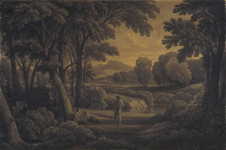
Pastorale, Claude François Théodore Caruelle d'Aligny
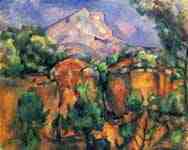
Montagne Sainte-Victoire and Chateau Noir, Paul Cézanne

Tahitian woman with Mango, Paul Gauguin
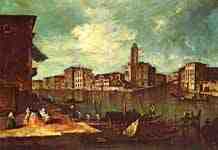
The Grand Canal at San Geremia , Francesco Guardi
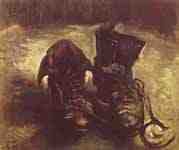
Still Life, A Pair of Shoes , Vincent Willem van Gogh
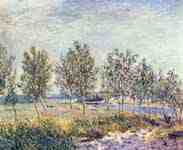
Meadow in By , Alfred Sisley
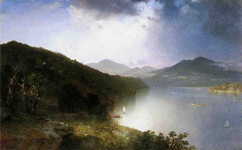
View on the Hudson , John Frederick Kensett
The Baltimore Museum of Art, located in Baltimore, Maryland, United States, is an art museum that was founded in 1914. Its main building was built in 1929, in the "Roman Temple" architectural style, under the design of famous architect John Russell Pope. The Museum is home to an internationally renowned collection of art that spans centuries and a number of periods; from early Byzantine to current Contemporary, many diverse artistic styles are represented. Originally known as the Municipal Art Museum, the B.M.A. today has over 90,000 works of art—including the largest holding of works by Henri Matisse in the world. It is located between the Charles Village, to the east, Remington, to the south, Hampden, to the west; and south of the Roland Park neighborhoods, immediately adjacent to the Homewood campus of The Johns Hopkins University, though the museum is an independent institution that is not affiliated with the University.
The highlight of the museum is perhaps the Cone Collection, brought together by famed Baltimore collecting sisters Dr. Caribel (1864–1929) and Miss Etta Cone (1870–1949). Accomplished collectors, these sisters amassed a wealth of works by artists including Matisse, Picasso, Cézanne, Manet, Degas, Giambattista Pittoni, Gauguin, van Gogh, and Renoir, nearly all of which were eventually donated to the Museum.
Since Sunday, October 1, 2006, the Baltimore Museum of Art and the older Walters Art Museum (formerly Walters Art Gallery), have had free admission year-round as a result of grants given by Baltimore City and Baltimore County, excepting for special exhibitions.[1]
The Baltimore Museum of Art is the site of Gertrude's Restaurant, owned and operated by chef John Shields.
History
BaltimoreMuseumofArt.JPG
Baltimore Museum of Art entrance.jpg
In February, 1904, a major fire destroyed much of the central part of the downtown business district of the city of Baltimore. In response, the municipal government established a City-Wide Congress to develop a master plan for the city's recovery and future growth and development. The congress, headed by Dr. A.R.L. Dohme, decided among other things that a major deficiency of the city was the lack of an art museum. This decision led to the formation of an eighteen-person Committee on the Art Museum led by art dealer and industrialist Henry H. Wiegand as the Chairman. Ten years later, the museum was officially incorporated on November 16, 1914.[2] Along with Minneapolis and Cleveland, Baltimore's museum was "modeled after two prominent 1870s predecessors, the Metropolitan Museum of Art in New York and the Museum of Fine Arts, Boston".[3] According to a booklet published at the time of incorporation, it was stated that Baltimore lagged behind other cities “in regard to matters of esthetic interest.”
Still without a permanent site, the fledgling Museum was founded with but a single painting, William-Sergeant Kendall's "Mischief", which was donated by Dr. Dohme himself. As the Museum's founders were confident more art would eventually be acquired, the nearby Peabody Institute agreed to hold the museum's collection for a time until a permanent home was established.[4] At this time, the committee began planning a permanent home for the museum's holdings.
In 1916, a building was purchased on the southwest corner of North Charles and West Biddle Streets as a possible location for the museum. Although an architect was employed to remodel it, it was never occupied. In 1915 the group had by then decided to permanently house the museum in the Wyman Park area, west of the then named Peabody Heights, (later Charles Village) neighborhood. By 1917 the group had received a promise from The Johns Hopkins University for the land further south of the new Georgian Revival architecture-Federal styled campus they were in the process of moving to. This prospective plot was near the old Homewood Mansion of 1800 and the later Italianate style mansion of "Wyman Villa" of a Hopkins donor and trustee, William Wyman, which would see them leave their downtown site at North Howard Street and West Centre, which they had occupied since 1876. However, before finally moving into its permanent home in 1929, the Museum was temporarily moved in July 1922 to the former home of their prime benefactor and foundress, Mary Elizabeth Garrett, (1857-1915) at 101 West Monument Street, on the southwest corner with Cathedral Street, (facing West Mount Vernon Place and the Washington Monument). Miss Garrett, a famous philanthropist in her own right who also further endowed the Johns Hopkins School of Medicine, was the only daughter of John Work Garrett (1820-1884), the famous Civil War-era President of the Baltimore and Ohio Railroad, supporter of President Abraham Lincoln and scion of the noted Robert Garrett banking firm in the city. In 1923 the museum’s inaugural exhibition opened there with attendance topping 6,775 during its first week.[5] The house was offered by Miss M. Cary as a home for the "collections" and a meeting place for the board of trustees. The old Garrett mansion was acquired in 1925 by the group of art enthusiasts who bought the property for the purpose of keeping the museum intact. Despite having limited space, the Museum offered accommodations to art associations and a hall for meetings.
Auguste Rodin's "The Thinker" (1904).
Meanwhile, back at Wyman Park, prominent architect John Russell Pope, (1874-1937), was engaged to design the museum's permanent home. With his years of study in Europe, John Russell Pope is considered to be the main examplar of the classical revival style that proved so popular with traditional American architects. He's credited with a number of major buildings along the American east coast and abroad including the National Archives Building in Washington, New York's American Museum of Natural History, and the Tate Gallery Sculpture Hall in London.[6] His distinct brand of classicism, both serene and monolithic at once, was perhaps the perfect choice for such an ambitious project.
The cornerstone was laid on October 20, 1927, facing the future Art Museum Drive and running diagonally from North Charles Street. The systems engineering for the building's original design was completed by Henry Adams, noted local mechanical engineer. The building consists of three floors and includes several rooms that were reconstructed and/or replicated from six local Maryland historic houses before their loss or razing.[7] The building phase was marked by controversy over its location, cost, and the quality of workmanship, but on April 19, 1929, it opened on schedule without much fanfare. The first visitors were greeted by Rodin's "The Thinker" in the Sculpture Court and most of the objects on display were lent by Baltimore and Maryland collectors. An average of 584 visitors attended the museum each day during the first two months of its opening. When the Museum opened in 1929, the library was on the ground floor, equipped with shelves to house several thousand volumes, reading tables, and chairs. In 1983, the Library was reinstalled in its current location, on the third floor of the Cone Wing.[8]
The "Eltonhead Manor Room" is one of six rooms at the Baltimore Museum of Art that replicates a historic Maryland house.
By the 1930s, the public reception was such that then-director Roland McKinney, in a letter to board chairman Henry Treide, noted, “People seem to feel that the Museum belongs to them and show that they are sincerely proud of it and its activities.” Unfortunately, these “people” were mostly upper- crust, privileged, and white, a fact duly noted in a 1937 Carnegie Corporation report. “[Baltimore] cultural institutions (outside of the library and the schools) have appealed to, been intended for, and been supported by a pretty small minority. . . .they need to be opened up, for the viewpoint of the entire community and its needs” it concluded. Local artists were feeling slighted, as well. “We, the living, resent being left to work in a vacuum of indifference and neglect while so much of the dead past is exhausted [by the BMA],” the president of the Artists’ Union of Baltimore complained to The Evening Sun in 1937. The writer of the letter was Morris Louis, whose work, decades later, would become a cornerstone of the BMA’s contemporary collection. Treide responded with an extensive community outreach survey and, in 1939, the city’s first exhibition of African-American art. The show drew over 12,000 visitors in two weeks.[4]
Many of the objects lent to the museum when it opened were eventually donated to The Baltimore Museum of Art. Among the generous donors who have shaped the museum's collection are Blanche Adler, Dr. Claribel Cone and Miss Etta Cone, Jacob Epstein, Edward J. Gallagher, Jr., John W. and Robert Garrett, Mary Frick Jacobs, Ryda H. and Robert H. Levi, Saidie Adler May, Dorothy McIlvain Scott, Elsie C. Woodward, and Alan and Janet Wurtzburger. The growing collection is reflected in the three major expansions that occurred in the 1950s: the Saidie A. May Wing in 1950, the Woodward Wing in 1956, and the Cone Wing in 1957. The three additions were all designed by local architects Wrenn, Lewis and Jencks to harmonize with the original Pope Building.
Today, The Baltimore Museum of Art's collection includes more than 90,000 objects, making it the largest art museum in Maryland. It is governed by a private Board of Trustees and receives funding from the City of Baltimore and the following surrounding suburban counties: (Baltimore County, Anne Arundel, Harford, Carroll, Howard and Frederick Counties), the State of Maryland, various corporations and foundations, federal agencies, individual Trustees, and many private citizens. The Baltimore Museum of Art welcomes more than 200,000 visitors annually. In addition to its impressive art collection, it organizes and hosts traveling exhibitions and serves as a major arts center through its programs.
Most recently, the first phase of the B.M.A.'s $28 million multi-year renovation was completed with the reopening of "Contemporary Wing" in November 2012. The next phase of the renovation encompassing the "American Wing", galleries for African and Asian art, a new learning and creativity center, and lobby and shop has already been completed in 2015 and the full completion of the renovations will be on October 25, 2015 with the grand opening of the new $4.5 million, 5,500 SF "Center For People & The Arts".[9]
Also in April 2015, 17-year Museum Director, Dr. Doreen Bolger announced she would be retiring as Museum Director effective June 30, 2015. On June 25, 2015, the BMA appointed two Museum Co-Directors on an interim basis until a permanent replacement for Dr. Bolger is found, current Deputy Director of Curatorial Affairs, Mr. Jay Fisher and current Deputy Director for Finance and Administration Ms. Christine Dietze.
Recent developments
Renovation
Recently, the B.M.A. announced a series of reopenings that will revitalize the visitor experience of the museum and its outstanding collections, representing an unprecedented $28 million renovation.[10] In November, 2014, after being closed for almost 30 years, the historic neoclassical Merrick Entrance was reopened to the public to coincide with the museum's 100 year anniversary.[11] The Dorothy McIlvain Scott American Wing, East Wing Lobby and Zamoiski Entrance were also similarly refurbished. The BMA also announced the expansion of its renovation plans for the first floor of the building to include expanded galleries for its African and Asian art collections and an exciting new learning and creativity center for visitors of all ages. The galleries for the African and Asian art collections were reopened with a schedule of activities to mark the event in 2015.[12]
The first phase of the B.M.A.’s ambitious renovation was completed in November 2012 with the successful reopening of the "Contemporary Wing". The current phase encompasses the first and second floors of the B.M.A.’s original 1929 building designed by the acclaimed American architect John Russell Pope, the 1982 "East Wing" Lobby and Zamoiski Entrance designed by Bower, Lewis & Thrower, and critically important upgrades to the museum’s infrastructure. The architect for this phase of the renovation is the Baltimore-based architecture firm Ziger/Snead. Construction is being completed by Whiting-Turner Contracting Company of Towson, Maryland, and the project manager is Synthesis, Inc., of Columbia, Maryland.
The $28 million budget for the renovation includes $6.5 million for the first phase—"Contemporary Wing", two new roofs, and a new fire suppression system. The B.M.A. has already raised $21.3 million to support the renovation through the "In a New Light" philanthropic campaign, including $11.25 million in capital contributions from the State of Maryland and $2.95 million from the City of Baltimore.
The renovations to the BMA will be completed on October 25, 2015 with the grand opening of the new $4.5 million, 5,500 SF "Center For People & The Arts".[9]
Fall 2014 reopenings
"Merrick Entrance" — The reopening of the original entrance to the B.M.A.’s John Russell Pope-designed building heralds the museum’s goal to open its doors and provide more welcoming and memorable art experiences throughout the facility. Closed to the public since 1982, the newly reopened threshold establishes the Museum’s terrace steps as a community gathering place.
"Dorothy McIlvain Scott American wing" — Considered the B.M.A.’s largest work of art, the first Pope-designed museum building will be revitalized with improvements that include reinstalling the original chandeliers and refurbishing the terrazzo floors. Nine adjacent galleries will feature a chronological presentation of hundreds of masterworks from the museum’s expansive holdings of American fine and decorative arts, considered one of the finest on the East Coast. Dedicated areas will showcase Maryland’s influence in art, architecture, decoration, and collecting, as well as a selection of stunning glass works by Louis Comfort Tiffany.
"East wing lobby and Zamoiski entrance" — A complete renovation of the museum’s east entry will create a more open and expansive central gathering place for visitors. Improvements include the relocation of the main stair to create a more inviting connection with the second floor, a gracefully curved wall that delineates the new retail space, and a lighter and more modern material palette for all lobby surfaces. Enhanced visitor amenities include an expanded BMA Shop, more restrooms, and additional seating.
Late spring 2015 reopenings
"Wurtzburger African Art Gallery" — The gallery for the BMA’s celebrated African art collection will be relocated to the center of the building on the first floor of the museum and expanded to more than three times its former space. The new presentation of the museum’s African art collection will include more than 100 objects in changing and thematic displays that will encourage visitors to appreciate the complexity and diversity of African art and cultures.
"Asian Art Galleries" — Two new galleries on the first floor of the museum, including the relocated Levy Gallery, will enlarge and enhance the display of approximately 160 highlights from the BMA’s collection of Asian art, including objects from China, Japan, India, Tibet, Southeast Asia, and the Near East.
October 2015 reopening
"Learning and Creativity Center" — A new 5,000-square-foot space will transform the visitor experience through a combination of art, technology, interpretation, hands-on art-making, and innovative programs that will inspire visitors of all ages.[9] Located adjacent to the renovated East Wing Lobby and Zamoiski Entrance, the center will include five interrelated areas beginning with a thematic interactive exhibition gallery that invites visitors to encounter works from the collection from different time periods, cultures, and media. Other areas include a community commons, an art-making studio, a research and learning space for docents, and a revitalized entrance for school tours.
Retirement of Bolger and appointment of co-directors and chairperson
In April 2015, Dr. Doreen Bolger, 17-year Museum Director of the BMA announced she would retire as Museum Director effective June 30, 2015.[13] In a May 2015 interview with Baltimore Magazine, Dr. Bolger reveals why she decided to retire, gave a retrospective of what occurred at the BMA and in Baltimore during her 17-year tenure, what she wants to do post-retirement, Dr. Bolger also confirmed in this interview that she will remain a resident of Baltimore, Maryland.[14] On June 25, 2015, the BMA published a press release revealing that current Deputy Director of Curatorial Affairs, Mr. Jay Fisher, and Deputy Director for Finance and Administration, Ms. Christine Dietze have been named Interim Museum Co-Directors and effective as of July 1, 2015, Ms. Claire Zamoski Segal was appointed as the BMA's Board of Trustees Chairperson.[15]
Collections
African art
Baga female dance headdress from Guinea.
The BMA was one of the first museum's in the United States to obtain a collection of African Art. A large part of the collection was donated by Janet and Alan Wurtzburger in 1954. The collection contains more than 2,000 objects that range from ancient Egypt to contemporary Zimbabwe and includes works from many other cultures including Bamana, Yoruba, Kuba, Ndebele, and others. The collection includes many different forms of art including headdresses, masks, figures, royal staffs, textiles, jewelry, ceremonial weapons, and pottery. Several of the pieces are known for their use in royal courts, performances, and religious contexts, and many are internationally known.
Highlights of the collection include works by carvers Zlan and Sonzanlwon and several figures by the legendary brasscaster Ldamie. Also on display are a Lozi throne (c. 1900) most likely carved in the court of King Lewanika of western Zambia, a 20th-century Hausa Koranic prayer board, and a 2006 video work by Theo Eshetu. At least everal of the masks and figurative sculptures are recognized internationally as the best of their type.[16]
American art
In the Grove (c. 1888) by Theodore Robinson.
The BMA has one of the best collections of American Art in the world with works spanning from the colonial era to the late 20th century. The exhibit contains American paintings, sculptures, and decorative arts. The museum contains several works of Art from the Baltimore area including portraiture by Charles Willson Peale, Rembrandt Peale, and other members of the renowned Peale family; silver from Baltimore's prominent silver manufacturing company Samuel Kirk & Son; American Baltimore album quilts; and painted furniture by John Finlay and Hugh Finlay of Baltimore.
The American painting collection at the museum ranges from 18th-century portraits and 19th-century landscape painting to American Impressionism and modernism with works by acclaimed artists John Singleton Copley, Thomas Sully, Thomas Eakins, John Singer Sargent, Childe Hassam, and Thomas Hart Benton. Notable canvases include A Wild Scene (1831–1832) by Thomas Cole, La Vachère (1888) by Theodore Robinson, and Pink Tulip (1926) by Georgia O'Keeffe. These are complemented by outstanding holdings of prints and drawings, as well as modern photographs from the Gallagher/Dalsheimer Collection. Artists represented include by Imogen Cunningham, Man Ray, Paul Strand, and Alfred Stieglitz.
The BMA has a long and distinguished record of collecting works by African-American artists that began in 1939 with one of the first exhibitions of African-American art in the country. This collection has grown substantially in recent years with the addition of more than 50 historical and contemporary works. Joshua Johnson, Jacob Lawrence, Edmonia Lewis, Horace Pippin, and Henry Ossawa Tanner are included among the 19th- and 20th-century African-American artists.
The BMA’s holdings of American decorative arts include an extensive furniture collection that represents the major historic cabinetmaking centers of Baltimore, Philadelphia, New York City, and Boston. Many of these objects came from Miss Dorothy McIlvain Scott, a generous Baltimore philanthropist and collector.
A remarkable gift in 1933 by Mrs. Miles White, Jr. of over 200 stunning pieces of Maryland silver formed the nucleus of an impressive silver collection that now embraces objects by leading 18th- and early 19th-century silversmiths in Annapolis and Baltimore, as well as elegant examples of early English silver owned by Maryland families during the Federal era. Among them is the Annapolis Subscription Plate, made by Annapolis silver smith John Inch and the oldest surviving silver object made in Maryland. Later masterworks by artists from Louis Comfort Tiffany to Georg Jensen are also on view.
Other notable aspects of the decorative arts collection include a rare set of five clerestory windows and two brilliant mosaic-clad architectural columns that represent Tiffany's lasting contribution to 20th-century ornament. Period rooms from six historic Maryland houses, along with architectural elements from other historic buildings, illustrate town and country building styles from the 18th and 19th centuries, and a dozen miniature rooms made by Chicago miniaturist Eugene Kupjack invite scrutiny of a variety of decorative styles at close range.
Antioch mosaics
Bust of Tethys, third century Antioch mosaic.
The BMA exhibits a distinguished collection of Antioch mosaics, the result of its participation in excavations of this ancient city, known today as Antakya in southeastern Turkey, near the border of Syria.
With the support of BMA Trustee Robert Garrett, The Baltimore Museum of Art joined the Musées Nationaux de France, Worcester Art Museum, and Princeton University during the excavations of 1932 to 1939, discovering 300 magnificent mosaic pavements in and around the lost city. The BMA received some of the finest mosaics from the excavation, totaling 34 pavements, 28 of which are on display in the Museum’s sunlit atrium court.
Discovered in the affluent suburb of Daphne and the nearby port city of Seleucia Pieria, the mosaics date from the days of the emperor Hadrian in the 2nd century A.D. to the Christian empire of Justinian in the 6th century, bridging the Classical world and the early Middle Ages. The mosaics illustrate how the classical art of Greece and Rome evolved into the art of the early Christian era and tell the story of how people lived in this ancient city prior to its destruction by catastrophic earthquakes in 526 and 528 A.D. The mosaics are notable for their grand scale and elaborately patterned borders, and the brilliance of their decorative and naturalistic effects.
Art of the ancient Americas
A Mexican stone waist belt in the form of a saurian monster (6th–10th-century).
This collection contains works from 59 distinct artistic traditions from Aztec and Maya of Mesoamerica, Chimú and Muisca of Andean South America, and Nicoya and Atlantic Watershed of Costa Rica. The collection includes works from 2500 BC to AD 1521. The core collection of 120 objects was given to the museum by Alan Wurtzburger in 1958, which significantly expanded the scope of the existing collection and provided momentum for a traveling exhibition of Peruvian ceramics titled Myths of Ancient Peru (1969).
The collection is particularly admired for its West Mexico ceramics, including an important Nayarit house model and an enthroned chief. Also on display is a unique assemblage of 23 figures in dance regalia which celebrates ancient performance and highlights the diversity of Colima art.
Other notable pieces include a finely worked serpentine figure of Olmec mastery, elegant portrayals of Maya and Aztec noblewomen showcasing the integral roles women played in the social, political, economic, and spiritual realms of society, and miniature gold votives in the Muisca tradition.
Art of the pacific islands
A 19th-century ancestral dance shield representing a frigate bird (Kai Diba). From the Trobriand Islands, New Guinea. Made of wood and polychrome.
This exhibit includes artwork from several cultural traditions of the Pacific Islands including those of Melanesia and Polynesia. Works in collection include a cross section of objects such as jewelry, ornaments, and tapa cloths.
Of notable interest is a finely carved lizard of dark wood and shell from Easter Island, a battle pectoral created from hundreds of Nassa shells, which highlights Middi art of New Britain, and an 18th-century royal Hawaiian necklace.
Other highlights of the collection include a breast ornament embellished with small birds and stars that figured as insignia of prestige for the Tonga of the Fiji Islands. Featuring whale ivory and pearl shell design, it is recognized as one of the largest of its kind.
Asian art
Early-eighth-century Tang Dynasty earthenware with green, straw, and amber lead glazes.
The museum's Asian art collection includes works from China, Japan, India, Tibet, Southeast Asia, and the Near East. The collection is particularly known for its Chinese ceramics, with a particular depth in mortuary wares from the Tang Dynasty (618–907) and utilitarian stonewares from the 11th through the 13th centuries. Although more than 1,000 objects are comprised by this collection, due to limited space only a portion of the pieces are on display at one time. Works are on view in rotating installations in the museum's Julius Levy Memorial Gallery.
Some notable works in the collection include the life-sized early-15th-century bronze Guanyin, known widely as "Goddess of Mercy"; the robust figure of a horse from a Han dynasty tomb; a 39-piece mortuary retinue, a rare example of the quantities of clay figures that were placed in tombs during the early Tang dynasty; and an outstanding foliate-shaped brush washer that represents the mastery of Chinese blue-and-white porcelain. Asian art is also represented in other areas of the museum's collection, including 475 Japanese prints and 1,000 textiles from across Asia.
European art
Madonna and Child in a Landscape (c. 1540) by Francesco Bacchiacca.
The European Art collection at the BMA contains works from the 15th through 19th centuries. Most of the collection was formed through generous donations made by private citicens of the city of Baltimore, notably Mary Frick Jacobs, George A. Lucas, and Jacob Epstein. The collection contains a large selection of 19th-century French art including more than 140 bronze animal sculptures by Antoine-Louis Barye and several paintings by Barbizon artists such as Jean-Baptiste-Camille Corot and impressionist Camille Pissarro. The collection also includes a wide array of decorative arts, including jeweled snuffboxes, porcelain, and silver. The museum also exhibits a large collection of works on paper from the 15th through the 19th century.
Highlights of the European art exhibit include Sir Anthony van Dyck's Rinaldo and Armida (1629) which was commissioned by King Charles I of England. It is considered one of the world’s finest paintings by the artist. Other masterworks of northern European and French art include Frans Hals’ portrait Dorothea Berck (1644), Rembrandt van Rijn’s painting of his son Titus (1660), Jean-Baptiste-Siméon Chardin’s portrayal of a lovely maiden tossing a ball in The Game of Knucklebones (c. 1734), and French court portraitist Louise Élisabeth Vigée Le Brun’s exotic Princess Anna Alexandrovna Galitzin (c. 1797). Medieval and Renaissance works include a 14th-century Burgundian Virgin and Child carved of limestone and Titian’s Portrait of a Gentleman (1561). There are also late-medieval and Renaissance paintings by Giovanni Dal Ponte, Biagio D'Antonio, Sandro Botticelli and Workshop, Bernardino Luimi, Francesco Ubertini, and Master of View of Saint Gudule.
In 2012, a Renoir that was stolen from the museum resurfaced after being lost for 63 years. The Renoir went on to become the subject of a dramatic legal dispute involving the FBI, the woman who said she found the painting, an insurance company's rights to the artwork and the intentions of Saidie May, an art collector who bought the painting in Paris in 1925 and lent it to the Baltimore museum. A judge later deemed it to be the property of the museum after reviewing related documentation from its archives. At the time of its theft, Fireman's Fund Insurance Co., paid the museum about $2,500 for the loss in 1951. The company considered whether to make a claim for the painting when it resurfaced but decided "it belonged" at the museum, said the insurer's general counsel.[17]
Cone collection
Paul Cézanne's Montagne Sainte-Victoire
The Cone Collection was the work of the Cone sisters, Claribel and Etta Cone, who in the early 20th century set out to acquire as much as they could of the work of artists such as Matisse and Picasso especially, and also Cézanne, Gauguin, Van Gogh, and Renoir among other major artists of the era.
Contemporary wing
The BMA's Contemporary Wing was built and opened in 1994, closed in January 2011 for renovations, and reopened in November 2012 with state-of-the-art lighting and new wall and floor finishes; a gallery dedicated to light, sound, and moving image-based art; a dedicated gallery for prints, drawings and photographs; and BMA Go Mobile, a brand new mobile website guide for the Contemporary Wing.
The newly renovated Contemporary Wing also houses a two-part architectural intervention that made the BMA the very first museum in the United States to commission and acquire a site-specific installation by award-winning artist Sarah Oppenheimer. It also showcases works by Olafur Eliasson, Jasper Johns, Robert Rauschenberg, Andy Warhol, Franz West, Yayoi Kusama, Donald Judd and other eminent artists alongside thrilling new acquisitions from 21st-century artists such as Guyton\Walker, Josephine Meckseper, Sarah Sze, and Rirkrit Tiravanija. There are also contemporary works by Oliver Herring, Phillip Guston, Sarah Oppenheimer, Ed Ruscha, and Olafur Eliasson at this art museum. The works of celebrated American artist Bruce Nauman, known for his work with neon lights, can be seen both in the contemporary collection and adorning the outside of the Museum itself, as is the case with his piece entitled "Violins, Violence, Silence".[18] The Baltimore Museum of Art has the second largest collection of Warhol's work in the USA.
See also
Walters Art Museum, (formerly the Walters Art Gallery), a public art museum in Baltimore
William Thompson Walters,
Henry Walters,
Claribel Cone, donator, Cone Collection
Etta Cone, donator, Cone Collection
Saidle May, donator
Paysage bord du Seine, Renoir painting
References
"Free admission at Baltimore Museum of Art and Walters Art Museum begins October 1". Groundbreaking cooperation and financial support from Baltimore City and Baltimore County provides greater public access to world-class art. Archived from the original on 2 October 2006. Retrieved September 23, 2006.
http://www.baltimoresun.com/news/opinion/editorial/bs-ed-bma-20141123-story.html
http://www.nytimes.com/2015/03/19/arts/artsspecial/four-museums-plan-their-centennials.html?_r=0
http://www.baltimoremagazine.net/2014/10/20/fall-arts-preview-bma-turns-100
https://artbma.org/documents/press/BMAHistoryHighlights_1914-2014_final.pdf
http://biography.yourdictionary.com/john-russell-pope
http://www.baltimoresun.com/features/59462,0,2882861.venue
http://www.marylandartsource.org/institutions/detail_000000014.html
"BMA Completes Renovation With New Center For People & Art Opening October 25 With Imagining Home Exhibition" (PDF). July 24, 2015. Retrieved August 12, 2015.
https://artbma.org/documents/press/RELEASE_FigureDrawings.pdf
https://news.artnet.com/in-brief/baltimore-museum-of-art-reopens-main-entrance-after-over-30-years-48027
http://www.baltimoremagazine.net/2015/4/21/bma-showcases-newly-renovated-african-and-asian-art-galleries
"Baltimore Museum of Art Director Doreen Bolger to retire - Baltimore Business Journal". Retrieved 2015-08-12.
"Q&A With Doreen Bolger - Baltimore magazine". Retrieved 2015-08-12.
"BMA ANNOUNCES NEW BOARD CHAIR AND INTERIM CO-DIRECTORS" (PDF). June 25, 2015. Retrieved August 12, 2015.
http://www.baltimoresun.com/entertainment/arts/bs-ae-bma-african-asian-20150425-story.html#page=1
http://www.att.net/
http://blog.artbma.org/tag/bruce-nauman/
Further reading
Flam, Jack. Matisse in the Cone Collection, Baltimore Museum of Art, 2001 ISBN 0-912298-73-1
Dackerman, Susan Painted Prints: The Revelation of Color in Northern Renaissance and Baroque Engravings, Etchings, and Woodcuts, Baltimore Museum of Art, 2002 ISBN 0-271-02235-3
----
Fine Art Prints | Greeting Cards | Phone Cases | Lifestyle | Face Masks | Men's , Women' Apparel | Home Decor | jigsaw puzzles | Notebooks | Tapestries | ...
----
A - B - C - D - E - F - G - H - I - J - K - L - M -
N - O - P - Q - R - S - T - U - V - W - X - Y - Z
A - B - C - D - E - F - G - H - I - J - K - L - M -
N - O - P - Q - R - S - T - U - V - W - X - Y - Z
Retrieved from "http://en.wikipedia.org/"
All text is available under the terms of the GNU Free Documentation License


